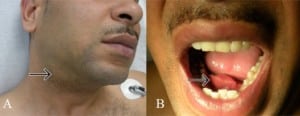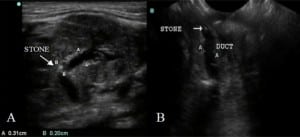| Author | Affiliation |
|---|---|
| Ryan M. Walsh, MD | Madigan Army Medical Center, Department of Emergency Medicine, Tacoma, WA |
| Hillary Harper, MD | Madigan Army Medical Center, Department of Emergency Medicine, Tacoma, WA |
| Brooks Laselle, MD | Madigan Army Medical Center, Department of Emergency Medicine, Tacoma, WA |
| Benjamin Harrison, MD | Madigan Army Medical Center, Department of Emergency Medicine, Tacoma, WA |
A 33-year-old man presented to the emergency department with two days of right-sided facial and submandibular swelling. He denied fevers, shortness of breath, difficulty swallowing or recent dental problems. The patient’s medical history was unremarkable and he had no similar prior symptoms. Physical exam was notable for a tender, firm, right-sided neck mass below the angle of the mandible and a tongue-like, soft-tissue protrusion of the right sublingual region (Figure 1). A bedside ultrasound was performed revealing two sialoliths and ductal dilatation (Figure 2). Otolaryngology was consulted and the stones were subsequently removed two days later via a transoral approach.


Sialolithiasis occurs most commonly in the submandibular gland (80%), followed by the parotid (15%), and the sublingual (<5%).1 The submandibular gland is more prone to calculi because: 1) the duct is longer and larger in diameter with slower saliva flow rates, 2) saliva flows against gravity, and 3) saliva is more alkaline, with a higher mucin and calcium content.
Ultrasound is 90% accurate in diagnosing sialolithiasis and was instrumental in the management of this patient.2 The initial plan was to administer IV antibiotics and obtain computed tomography (CT), to rule out a possible abscess. Ultrasound clinched the diagnosis in a rapid, accurate manner and permitted the avoidance of a CT scan and the associated radiation, cost and time delays.
The treatment of sialoliths generally involves conservative management. Patients with symptoms persisting for more than a few days should be referred to Otolaryngology. Sialoendoscopy, fluoroscopy-guided wire basket extraction, lithotripsy, and open surgical removal are options when expectant management fails or is inappropriate. Typically stones less than 2 mm in diameter can be treated without surgical intervention.3
Footnotes
The opinions or assertions contained herein are the private views of the authors and not to be construed as official or reflecting the views of the Department of the Army, the Department of Defense, or the U.S. Government.
Supervising Section Editor: Sean Henderson, MD
Submission history: Submitted March 11, 2010; Accepted March 22, 2010
Full text available through open access at http://escholarship.org/uc/uciem_westjem
Address for Correspondence: Ryan Walsh, MD, Dept. of Emergency Medicine, Madigan Army Medical Center, Bldg 9040 Fitzsimmons Ave, Tacoma, WA. 98431
Email: rdub88@gmail.com
Conflicts of Interest: By the WestJEM article submission agreement, all authors are required to disclose all affiliations, funding sources, and financial or management relationships that could be perceived as potential sources of bias. The authors disclosed none.
REFERENCES
1. Austin T, Davis J, Chan T. Sialolithiasis of Submandibular Gland. Journal of Emergency Medicine.2004;26:221–3. [PubMed]
2. Katz P, Hartl D, Guerre A. Clinical Ultrasound of the Salivary Glands. Otolaryngol Clin N Am.2009;42:973–1000.
3. Soares EC, Costa FW, Pessoa RM, et al. Giant salivary calculus of the submandibular gland.Otolaryngol Head Neck Surg. 2009;140:128–9. [PubMed]


